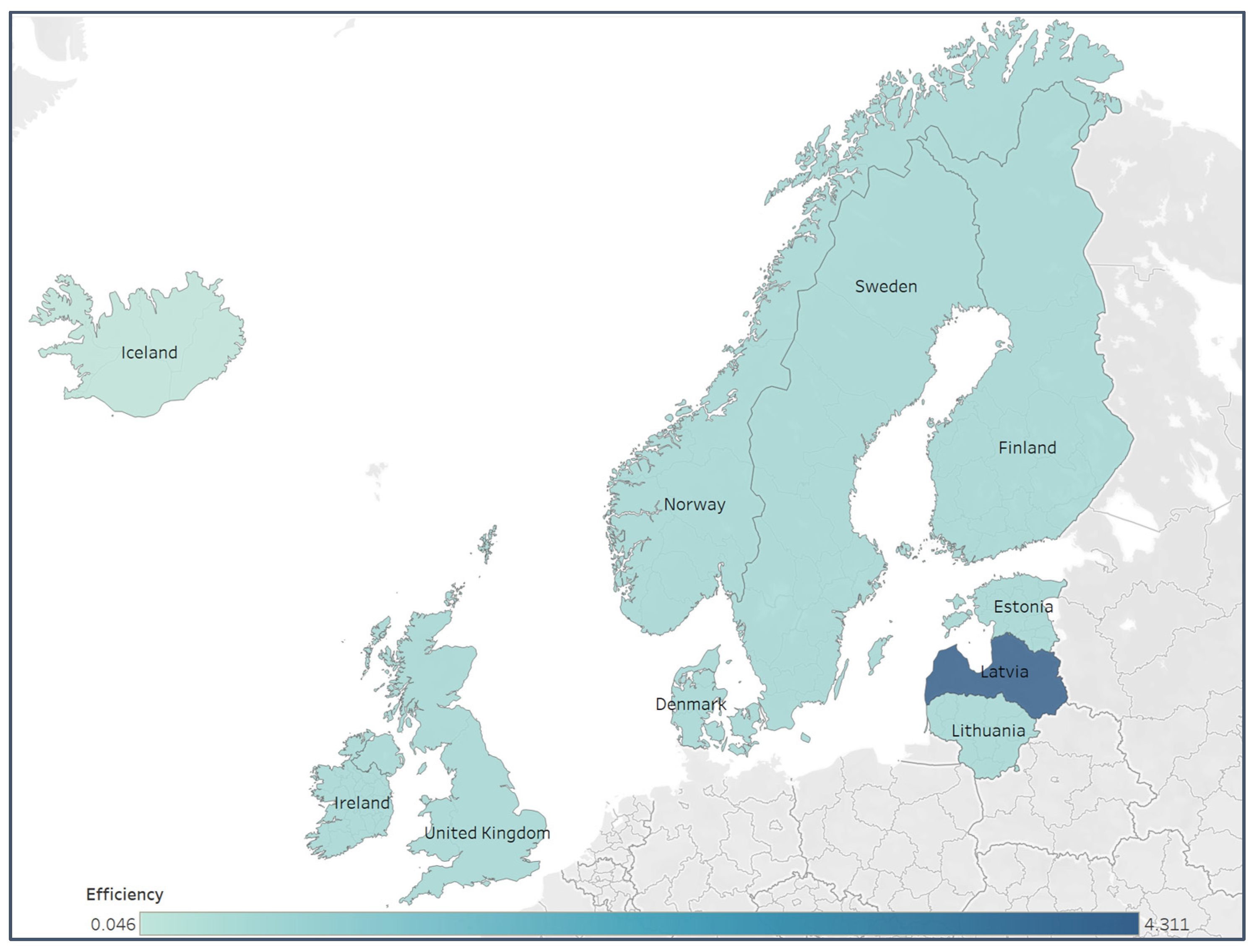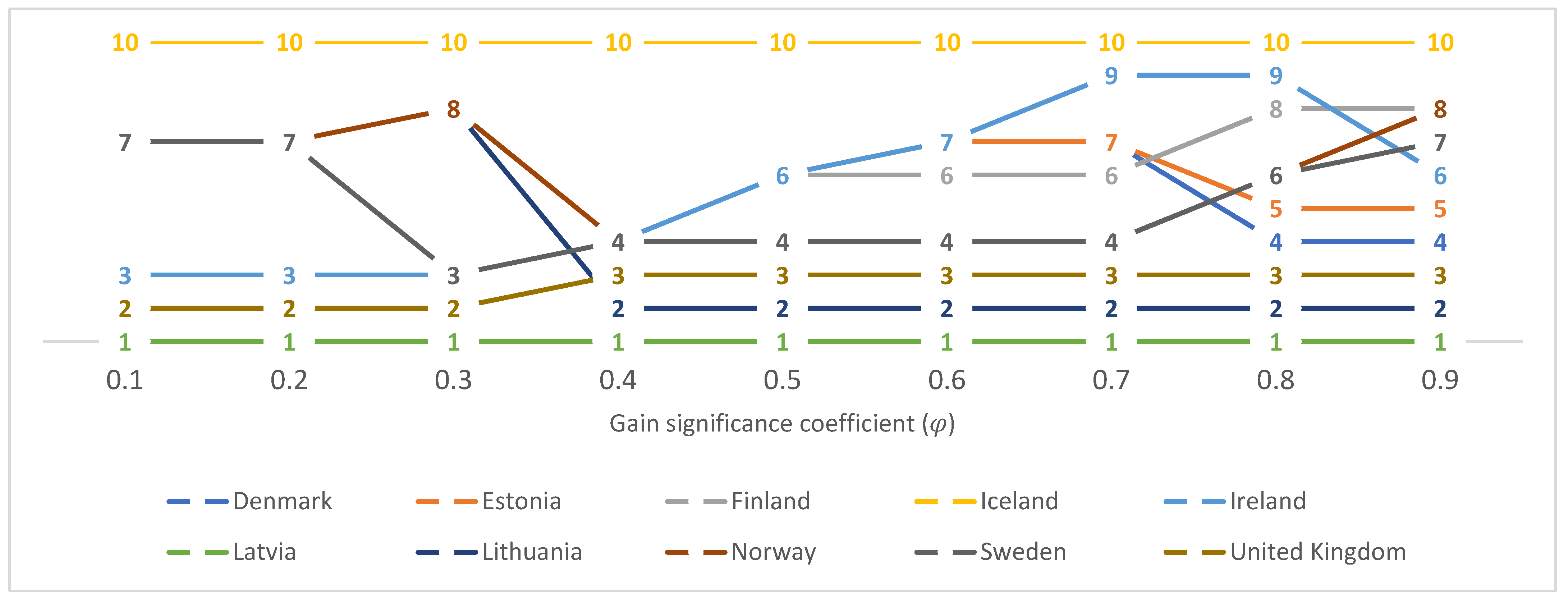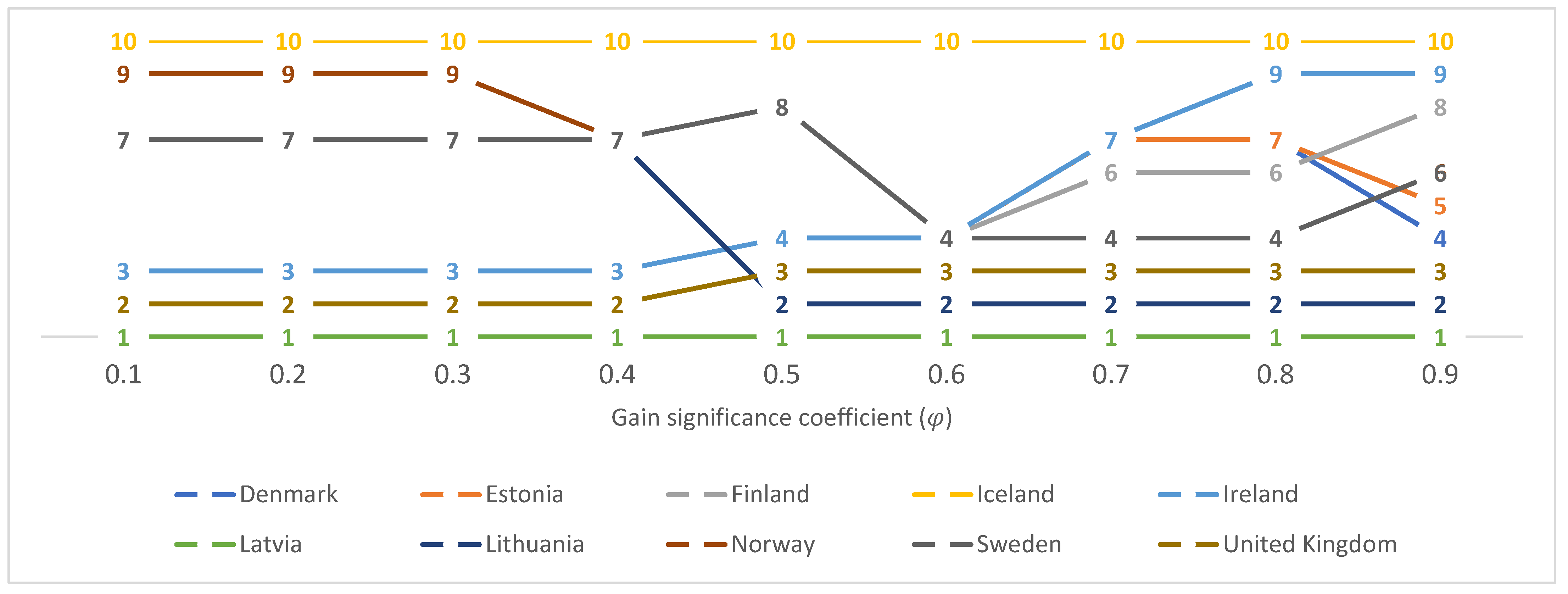Northern Lights: Prospecting Efficiency in Europe’s Renewable Energy Sector
Abstract
1. Introduction
2. Literature Review
2.1. Renewable Energy Studies in Northern Eupopean
2.2. Data Envelopment Analysis Studies
3. Methodology
3.1. Traditional DEA Model
3.2. Prospect Theory
3.3. The Behavioral DEA Model
4. Numerical Results
4.1. Problem Description
4.2. Data Collection and Behavioral DEA Application
4.3. The Loss Aversion Sensitivity Analysis
4.4. Discussion
5. Conclusions
Author Contributions
Funding
Data Availability Statement
Conflicts of Interest
Abbreviations
| Notation/Acronyms | Description |
| DEA | Data Envelopment Analysis |
| RE | Renewable energy |
| IEA | The International Energy Agency |
| EU | the European Union |
| ICT | Information and Communication Technology |
| MCDM | Multi-Criteria Decision-Making |
| CCR model | Charnes, Cooper and Rhodes model |
| BCC model | Banker, Chames and Cooper model |
| DMUs | the Decision-Making Units |
| GWh | gigawatt-hours |
| GDP | the Gross Domestic Product |
| US | The United States |
| Technical efficiency of th DMU | |
| Number of DMUs | |
| Number of input indicators | |
| Number of output indicators | |
| The weight assigned to the th output of DEA model | |
| The weight assigned to the th input DEA model | |
| The value of the th input for the th DMU | |
| The value of the th input for the th DMU | |
| The non-negative adjustment constants | |
| The difference in value with respect to the reference point according to Prospect theory | |
| The decision-makers’ attitudes towards gains | |
| The decision-makers’ attitudes towards losses | |
| The loss aversion coefficient | |
| The normalized value of | |
| The normalized value of | |
| The positive reference points for inputs | |
| The positive reference points for outputs | |
| The negative reference points for inputs | |
| The negative reference points for outputs | |
| The gain significance coefficient | |
| The behavior DEA model’s objective function value |
References
- Jordana, J.; Saz, A.; Marx, A.; Holesch, A.; Vandendriessche, M.; Coen, D.; Levi-Faur, D.; Rogers, C.; Zürn, M.; Tokhi, A.; et al. Trends in Global Governance and Future Scenarios 2030; Institut Barcelona d’Estudis Internacionals (IBEI): Barcelona, Spain, 2023. [Google Scholar]
- The Global Power Mix Will Be Transformed by 2028. 2023. Available online: https://www.iea.org/energy-system/renewables (accessed on 11 November 2023).
- Brodny, J.; Tutak, M. Assessing the energy security of European Union countries from two perspectives—A new integrated approach based on MCDM methods. Appl. Energy 2023, 347, 121443. [Google Scholar] [CrossRef]
- Duarte, P.A.B.; FLeandro, J.B.S.; Galán, E.M. The Palgrave Handbook of Globalization with Chinese Characteristics: The Case of the Belt and Road Initiative; Springer Nature: Berlin/Heidelberg, Germany, 2023. [Google Scholar]
- Where Does the EU’s Gas Come from? 2024. Available online: https://www.consilium.europa.eu/en/infographics/eu-gas-supply (accessed on 1 February 2024).
- Cross, S.; Hast, A.; Kuhi-Thalfeldt, R.; Syri, S.; Streimikiene, D.; Denina, A. Progress in renewable electricity in Northern Europe towards EU 2020 targets. Renew. Sustain. Energy Rev. 2015, 52, 1768–1780. [Google Scholar] [CrossRef]
- Renewable Energy Targets. 2023. Available online: https://energy.ec.europa.eu/topics/renewable-energy/renewable-energy-directive-targets-and-rules/renewable-energy-targets_en (accessed on 11 May 2023).
- Bahgat, G. Europe’s energy security: Challenges and opportunities. Int. Aff. 2006, 82, 961–975. [Google Scholar] [CrossRef]
- Bigerna, S.; Bollino, C.A.; Micheli, S. The Sustainability of Renewable Energy in Europe; Springer: Berlin/Heidelberg, Germany, 2015. [Google Scholar]
- Parhamfar, M.; Sadeghkhani, I.; Adeli, A.M. Towards the application of renewable energy technologies in green ports: Technical and economic perspectives. IET Renew. Power Gener. 2023, 17, 3120–3132. [Google Scholar] [CrossRef]
- Durakovic, G.; del Granado, P.C.; Tomasgard, A. Powering Europe with North Sea offshore wind: The impact of hydrogen investments on grid infrastructure and power prices. Energy 2023, 263, 125654. [Google Scholar] [CrossRef]
- Dogan, E.; Hodžić, S.; Šikić, T.F. Do energy and environmental taxes stimulate or inhibit renewable energy deployment in the European Union? Renew. Energy 2023, 202, 1138–1145. [Google Scholar] [CrossRef]
- Simionescu, M.; Rădulescu, M.; Cifuentes-Faura, J. Renewable Energy Consumption-Growth Nexus in European Countries: A Sectoral Approach. Eval. Rev. 2023, 47, 287–319. [Google Scholar] [CrossRef] [PubMed]
- Gyamfi, B.A.; Kwakwa, P.A.; Adebayo, T.S. Energy intensity among European Union countries: The role of renewable energy, income and trade. Int. J. Energy Sect. Manag. 2023, 17, 801–819. [Google Scholar] [CrossRef]
- Do, T.C.; Dang, T.D.; Dinh, T.Q.; Ahn, K.K. Developments in energy regeneration technologies for hydraulic excavators: A review. Renew. Sustain. Energy Rev. 2021, 145, 111076. [Google Scholar] [CrossRef]
- Ha, K.; Truong, H.V.A.; Dang, T.D.; Ahn, K.K. Recent Control Technologies for Floating Offshore Wind Energy System: A Review. Int. J. Precis. Eng. Manuf. Green Technol. 2021, 8, 281–301. [Google Scholar] [CrossRef]
- Inês, C.; Guilherme, P.L.; Esther, M.-G.; Swantje, G.; Stephen, H.; Lars, H. Regulatory challenges and opportunities for collective renewable energy prosumers in the EU. Energy Policy 2020, 138, 111212. [Google Scholar] [CrossRef]
- Radmehr, R.; Henneberry, S.R.; Shayanmehr, S. Renewable Energy Consumption, CO2 Emissions, and Economic Growth Nexus: A Simultaneity Spatial Modeling Analysis of EU Countries. Struct. Chang. Econ. Dyn. 2021, 57, 13–27. [Google Scholar] [CrossRef]
- Destek, M.A.; Aslan, A. Disaggregated renewable energy consumption and environmental pollution nexus in G-7 countries. Renew. Energy 2020, 151, 1298–1306. [Google Scholar] [CrossRef]
- Johannsen, R.M.; Mathiesen, B.V.; Kermeli, K.; Crijns-Graus, W.; Østergaard, P.A. Exploring pathways to 100% renewable energy in European industry. Energy 2023, 268, 126687. [Google Scholar] [CrossRef]
- Potrč, S.; Čuček, L.; Martin, M.; Kravanja, Z. Sustainable renewable energy supply networks optimization—The gradual transition to a renewable energy system within the European Union by 2050. Renew. Sustain. Energy Rev. 2021, 146, 111186. [Google Scholar] [CrossRef]
- Tutak, M.; Brodny, J. Renewable energy consumption in economic sectors in the EU-27. The impact on economics, environment and conventional energy sources. A 20-year perspective. J. Clean. Prod. 2022, 345, 131076. [Google Scholar] [CrossRef]
- Panchenko, V.; Daus, Y.; Kovalev, A.; Yudaev, I.; Litti, Y. Prospects for the production of green hydrogen: Review of countries with high potential. Int. J. Hydrogen Energy 2023, 48, 4551–4571. [Google Scholar] [CrossRef]
- Kaffash, S.; Azizi, R.; Huang, Y.; Zhu, J. A survey of data envelopment analysis applications in the insurance industry 1993–2018. Eur. J. Oper. Res. 2020, 284, 801–813. [Google Scholar] [CrossRef]
- Xu, T.; You, J.; Li, H.; Shao, L. Energy Efficiency Evaluation Based on Data Envelopment Analysis: A Literature Review. Energies 2020, 13, 3548. [Google Scholar] [CrossRef]
- Čiković, K.F.; Lozić, J. Application of Data Envelopment Analysis (DEA) in Information and Communication Technologies. Teh. Glas. 2022, 16, 129–134. [Google Scholar] [CrossRef]
- Dutta, P.; Jaikumar, B.; Arora, M.S. Applications of data envelopment analysis in supplier selection between 2000 and 2020: A literature review. Ann. Oper. Res. 2022, 315, 1399–1454. [Google Scholar] [CrossRef]
- Le, M.-T.; Nhieu, N.-L. An Offshore Wind–Wave Energy Station Location Analysis by a Novel Behavioral Dual-Side Spherical Fuzzy Approach: The Case Study of Vietnam. Appl. Sci. 2022, 12, 5201. [Google Scholar] [CrossRef]
- Kyrgiakos, L.S.; Kleftodimos, G.; Vlontzos, G.; Pardalos, P.M. A systematic literature review of data envelopment analysis implementation in agriculture under the prism of sustainability. Oper. Res. 2023, 23, 1–38. [Google Scholar] [CrossRef]
- Tavana, M.; Soltanifar, M.; Santos-Arteaga, F.J.; Sharafi, H. Analytic hierarchy process and data envelopment analysis: A match made in heaven. Expert Syst. Appl. 2023, 223, 119902. [Google Scholar] [CrossRef]
- Wang, C.-N.; Nhieu, N.-L.; Tran, H.-V. Wave Energy Site Location Optimizing in Chile: A Fuzzy Serial Linear Programming Decision-Making Approach. Environ. Dev. Sustain. 2024; early access. [Google Scholar]
- Wang, C.; Nguyen, H.; Nhieu, N.; Hsu, H. A prospect theory extension of data envelopment analysis model for wave-wind energy site selection in New Zealand. Manag. Decis. Econ. 2023, 45, 539–553. [Google Scholar] [CrossRef]
- Charnes, A.; Cooper, W.W.; Rhodes, E. Measuring the efficiency of decision making units. Eur. J. Oper. Res. 1978, 2, 429–444. [Google Scholar] [CrossRef]
- Banker, R.D.; Charnes, A.; Cooper, W.W. Some Models for Estimating Technical and Scale Inefficiencies in Data Envelopment Analysis. Manag. Sci. 1984, 30, 1078–1092. [Google Scholar] [CrossRef]
- Kahneman, D.; Tversky, A. Prospect Theory: An Analysis of Decision under Risk. Econometrica 1979, 47, 263. [Google Scholar] [CrossRef]
- Liang, H.; Xiong, W.; Dong, Y. A prospect theory-based method for fusing the individual preference-approval structures in group decision making. Comput. Ind. Eng. 2018, 117, 237–248. [Google Scholar] [CrossRef]
- Wang, L.; Wang, Y.-M.; Martínez, L. A group decision method based on prospect theory for emergency situations. Inf. Sci. 2017, 418–419, 119–135. [Google Scholar] [CrossRef]
- Le, M.-T.; Nhieu, N.-L. A Behavior-Simulated Spherical Fuzzy Extension of the Integrated Multi-Criteria Decision-Making Approach. Symmetry 2022, 14, 1136. [Google Scholar] [CrossRef]
- Chen, X.; Liu, X.; Wang, W.; Gong, Z. Behavioral DEA model and its application to the efficiency evaluation of manufacturing transformation and upgrading in the Yangtze River Delta. Soft Comput. 2019, 24, 10721–10738. [Google Scholar] [CrossRef]
- Tian, J.; Yu, L.; Xue, R.; Zhuang, S.; Shan, Y. Global low-carbon energy transition in the post-COVID-19 era. Appl. Energy 2022, 307, 118205. [Google Scholar] [CrossRef]
- IRENA. Renewable Energy Country Profiles; International Renewable Energy Agency: New York, NY, USA, 2022. [Google Scholar]
- Gunny, A.A.N.; Shahimin, M.F.M.; Mohamed, A.R.; Jalil, M.F.A. Current Status of Renewable Energy Development. In Renewable Energy from Bio-Resources in Malaysia; Springer: Singapore, 2022; pp. 1–19. [Google Scholar]
- Wang, C.-N.; Nhieu, N.-L. Integrated DEA and hybrid ordinal priority approach for multi-criteria wave energy locating: A case study of South Africa. Soft Comput. 2023, 27, 18869–18883. [Google Scholar] [CrossRef]
- Wang, C.-N.; Nhieu, N.-L.; Nguyen, H.-P.; Wang, J.-W. Simulation-Based Optimization Integrated Multiple Criteria Decision-Making Framework for Wave Energy Site Selection: A Case Study of Australia. IEEE Access 2021, 9, 167458–167476. [Google Scholar] [CrossRef]
- Le, M.-T.; Nhieu, N.-L.; Pham, T.-D.T. Direct-Use Geothermal Energy Location Multi-Criteria Planning for On-Site Energy Security in Emergencies: A Case Study of Malaysia. Sustainability 2022, 14, 15132. [Google Scholar] [CrossRef]
- Wang, C.-N.; Pham, T.-D.T.; Nhieu, N.-L.; Huang, C.-C. Smart Technology Prioritization for Sustainable Manufacturing in Emergency Situation by Integrated Spherical Fuzzy Bounded Rationality Decision-Making Approach. Processes 2022, 10, 2732. [Google Scholar] [CrossRef]
- The World Bank. World Bank Open Data. Available online: https://databank.worldbank.org/ (accessed on 11 November 2023).
- IEA. Energy Statistics Data; International Energy Agency: Paris, France, 2022. [Google Scholar]
- IEA. World Energy Investment 2022; International Energy Agency (IEA): Paris, France, 2022. [Google Scholar]
- IRENA. Global Atlas for Renewable Energy; International Renewable Energy Agency: Abu Dhabi, United Arab Emirates, 2022. [Google Scholar]
- IRENA. Renewable Energy Statistics 2022; International Renewable Energy Agency (IRENA): Abu Dhabi, United Arab Emirates, 2022. [Google Scholar]
- Tversky, A.; Kahneman, D. Advances in prospect theory: Cumulative representation of uncertainty. J. Risk Uncertain. 1992, 5, 297–323. [Google Scholar] [CrossRef]
- Wang, C.-N.; Nhieu, N.-L.; Dao, T.-H.; Huang, C.-C. Simulation-Based Optimized Weighting TODIM Decision-Making Approach for National Oil Company Global Benchmarking. IEEE Trans. Eng. Manag. 2022, 71, 1215–1229. [Google Scholar] [CrossRef]




| Country | Traditional Energy Production (GWh) | Population (Million) | Particulate Emission Damage Savings (% of GNI) | Electricity Output by Renewable Sources (GWh) | GDP (Current Billion US$) | Renewable Energy Consumption (% of Total Final Energy Consumption) |
|---|---|---|---|---|---|---|
| Input 1 | Input 2 | Input 3 | Output 1 | Output 2 | Output 3 | |
| Denmark | 6158.38 | 5.86 | 0.04 | 26,095.91 | 405.69 | 39.70 |
| Estonia | 4233.78 | 1.33 | 0.03 | 2878.53 | 37.19 | 40.00 |
| Finland | 9582.00 | 5.54 | 0.01 | 38,175.37 | 296.47 | 47.49 |
| Iceland | 2.46 | 0.37 | 0.02 | 19,611.73 | 25.60 | 82.79 |
| Ireland | 19,651.08 | 5.03 | 0.02 | 11,613.51 | 513.39 | 13.69 |
| Latvia | 2128.40 | 1.88 | 0.13 | 3717.82 | 39.44 | 43.75 |
| Lithuania | 1316.50 | 2.80 | 0.09 | 2621.70 | 66.80 | 31.70 |
| Norway | 897.80 | 5.41 | 0.01 | 156,101.28 | 503.37 | 61.29 |
| Sweden | 1375.00 | 10.42 | 0.01 | 115,737.00 | 639.71 | 58.40 |
| United Kingdom | 132,429.85 | 67.03 | 0.05 | 122,178.14 | 3141.51 | 13.50 |
| Country | Input 1 | Input 2 | Input 3 | Output 1 | Output 2 | Output 3 |
|---|---|---|---|---|---|---|
| Denmark | 0.954 | 0.968 | 0.928 | 1.000 | 0.852 | 0.984 |
| Estonia | 0.918 | 0.986 | 0.922 | 1.000 | 0.930 | 0.977 |
| Finland | 0.753 | 0.810 | 0.969 | 0.943 | 0.920 | 0.000 |
| Iceland | 0.153 | 0.002 | 0.232 | 0.111 | 0.059 | 0.007 |
| Ireland | 0.122 | 0.004 | 0.087 | 0.000 | 0.157 | 0.004 |
| Latvia | 0.378 | 0.382 | 0.491 | 1.000 | 0.003 | 0.437 |
| Lithuania | 0.954 | 0.968 | 0.928 | 1.000 | 0.852 | 0.984 |
| Norway | 0.918 | 0.986 | 0.922 | 1.000 | 0.930 | 0.977 |
| Sweden | 0.753 | 0.810 | 0.969 | 0.943 | 0.920 | 0.000 |
| United Kingdom | 0.153 | 0.002 | 0.232 | 0.111 | 0.059 | 0.007 |
Disclaimer/Publisher’s Note: The statements, opinions and data contained in all publications are solely those of the individual author(s) and contributor(s) and not of MDPI and/or the editor(s). MDPI and/or the editor(s) disclaim responsibility for any injury to people or property resulting from any ideas, methods, instructions or products referred to in the content. |
© 2024 by the authors. Licensee MDPI, Basel, Switzerland. This article is an open access article distributed under the terms and conditions of the Creative Commons Attribution (CC BY) license (https://creativecommons.org/licenses/by/4.0/).
Share and Cite
Hung, Y.-H.; Yang, F.-C. Northern Lights: Prospecting Efficiency in Europe’s Renewable Energy Sector. Processes 2024, 12, 618. https://doi.org/10.3390/pr12030618
Hung Y-H, Yang F-C. Northern Lights: Prospecting Efficiency in Europe’s Renewable Energy Sector. Processes. 2024; 12(3):618. https://doi.org/10.3390/pr12030618
Chicago/Turabian StyleHung, Yen-Hsing, and Fu-Chiang Yang. 2024. "Northern Lights: Prospecting Efficiency in Europe’s Renewable Energy Sector" Processes 12, no. 3: 618. https://doi.org/10.3390/pr12030618
APA StyleHung, Y.-H., & Yang, F.-C. (2024). Northern Lights: Prospecting Efficiency in Europe’s Renewable Energy Sector. Processes, 12(3), 618. https://doi.org/10.3390/pr12030618





